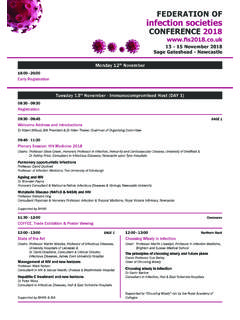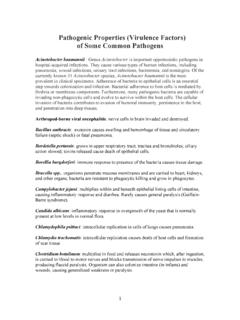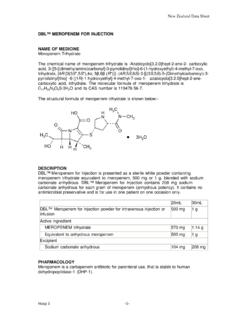Transcription of Antibiotic resistance of Clostridium perfringens …
1 Rev. sci. tech. Off. int. Epiz., 2013, 32 (3), .. - .. 09072013-00003-EN 1/19 Antibiotic resistance of Clostridium perfringens isolates from broiler chickens in Egypt This paper (No. 09072013-00003-EN) has been peer-reviewed, accepted, edited, and corrected by authors. It has no yet been formatted for printing. It will be published in December 2013 in issue 32-3 of the Scientific and Technical Review. Osman* & M. Elhariri Department of Microbiology, Faculty of Veterinary Medicine, Cairo University, Box 12211, Cairo, Egypt *Corresponding author: Summary The use of Antibiotic feed additives in broiler chickens results in a high prevalence of resistance among their enteric bacteria, with a consequent emergence of Antibiotic resistance in zoonotic enteropathogens.
2 Despite growing concerns about the emergence of Antibiotic -resistant strains, which show varying prevalences in different geographic regions, little work has been done to investigate this issue in the Middle East. This study provides insight into one of the world s most common and financially crippling poultry diseases, necrotic enteritis caused by Clostridium perfringens . The study was designed to determine the prevalence of Antibiotic resistance in C. perfringens isolates from clinical cases of necrotic enteritis in broiler chickens in Egypt. A total of 125 isolates were obtained from broiler flocks in 35 chicken coops on 17 farms and were tested using the disc diffusion method. All 125 isolates were resistant to gentamicin, streptomycin, oxolinic acid, lincomycin, erythromycin and spiramycin.
3 The prevalence of resistance to other antibiotics was also high: rifampicin (34%), chloramphenicol (46%), spectinomycin (50%), tylosin-fosfomycin (52%), ciprofloxacin (58%), norfloxacin (67%), oxytetracycline (71%), flumequine (78%), enrofloxacin (82%), neomycin (93%), colistin (94%), pefloxacin (94%), doxycycline Rev. sci. tech. Off. int. Epiz., 32 (3) 09072013-00003-EN 2/19 (98%) and trimethoprim-sulfamethoxazole (98%). It is recommended that C. perfringens infections in Egypt should be treated with antibiotics for which resistant isolates are rare at present; namely, amoxicillin, ampicillin, cephradine, fosfomycin and florfenicol.
4 Keywords Antibiotic resistance Broiler chickens Clostridium perfringens Egypt Middle East Necrotic enteritis. Introduction Necrotic enteritis is caused by the bacterium Clostridium perfringens , a soil-borne organism found on almost every poultry farm in dust, faeces, feed, poultry litter and intestinal contents, as well as in the soil (1). Clostridium perfringens is the aetiological agent of a wide range of diseases in humans and animals. Necrotic enteritis, one of the most economically important and financially crippling enteric poultry diseases in broiler chickens, causes the more commonly recognised fulminant infection which can result in outbreaks with mortality rates of up to 50% (2). In the global poultry industry, necrotic enteritis is considered an emerging billion-dollar disease (3, 4).
5 The disease emerged in broiler chickens in many European Union (EU) countries as a consequence of the ban on growth-promoting antibiotics in animal feed (3, 5, 6) and usually affects chickens between two weeks and six months of age, with the majority of reports from broilers aged two to five weeks (7). This ban, together with an increase in legislative restrictions and the voluntary removal of Antibiotic growth promoters worldwide, has been accompanied by increasingly apparent adverse consequences to poultry production and animal health (6). These antibiotics had an important prophylactic effect and their withdrawal is now associated with a deterioration in animal health, seen as increased diarrhoea, weight loss and mortality (5) and a resurgence in the incidence of clostridial necrotic enteritis in broilers (8).
6 At present, recommendations for the control and treatment of mild and subclinical necrotic enteritis are empirical and based on extensions of validated Rev. sci. tech. Off. int. Epiz., 32 (3) 09072013-00003-EN 3/19 approaches to control the classic form of the disease with approved antibiotics that have proven efficacy against C. perfringens (9, 10). As the costs of disease to the broiler industry are great (3), the use of antibiotics to prevent large financial losses has become more widespread. Antibiotic use in animals differs considerably between geographic regions (11), and so this study aims to determine the in-vitro resistance of C.
7 perfringens to some antibiotics which are relevant to poultry production (for treatment, prophylaxis and growth promotion), to obtain up-to-date information for Egypt. Methods Source of isolates A total of 125 C. perfringens isolates from previous field studies were selected to represent the period between 2009 and 2010 (12). The samples were originally collected and archived as part of other research and surveillance projects conducted by investigators in the Animal Health Diagnostic Centre of the Department of Microbiology in the Faculty of Veterinary Medicine at Cairo University. Bacterial identification Caecal contents were inoculated into phosphate-buffered saline (PBS: , ) and plated on Shahidi Ferguson perfringens (SFP) selective media plates (SFP agar base, Becton Dickinson Microbiology Systems), containing 400 g D-cycloserine (Sigma Aldrich, Saint Louis, Missouri, United States [USA]) as a further selective agent.
8 Plates were incubated anaerobically in an atmosphere of H2 and CO2 (GasPak; BBL) for 24 h at 37 C. Colonies with dark centres and/or diameters larger than 1 mm were selected in a systematic manner (12) to eliminate sampling bias and were sub-cultured on SFP plates. Colonies were further sub-cultured on sheep blood agar and checked visually for a typical C. perfringens double-haemolysis zone surrounding the colonies. A reverse Christie, Atkins, Munch-Petersen (CAMP) test (13) was used to confirm C. Rev. sci. tech. Off. int. Epiz., 32 (3) 09072013-00003-EN 4/19 perfringens identity. Bacterial suspensions were then frozen in brain heart infusion (BHI) broth with 20% glycerol at 70 C.
9 Identification of Clostridium perfringens isolates using polymerase chain reaction assay The 125 C. perfringens isolates, including C. perfringens ATCC 13124 as a positive control, were examined using polymerase chain reaction (PCR) assay. Staphylococcus aureus ATCC 29737 was used as a negative control. The boiling technique (14) was used to extract DNA from the isolates and multiplex PCR assay was used for toxinotyping (15). Antibiotic susceptibility testing At any one sampling time, a maximum of two isolates per chicken coop were selected for Antibiotic - resistance testing. The disc diffusion method was used, according to the recommendations of the British Society for Antimicrobial Chemotherapy (BSAC) (16), and was chosen for its simplicity and reproducibility.
10 The 25 most cost-effective antibiotics routinely used to treat C. perfringens infections (Table I) were tested (17). Antibiotic discs (BBL: Becton, Dickinson and Company, New Jersey, USA 07417) were purchased from Fisher Scientific (Pittsburgh, Philadelphia, USA) and Mast Diagnostics (Mast Group, Merseyside, UK). Susceptibility testing and interpretation took place in the Department of Microbiology in the Faculty of Veterinary Medicine at Cairo University. Isolates (1 105 colony-forming units) were plated on Columbia blood agar, using a Steers inoculum replicator, and incubated anaerobically overnight at 37 C. Colonies were then suspended in NaCl to a McFarland standard and diluted 40-fold. Cultures were incubated anaerobically for 24 h, with C.












